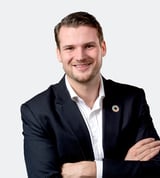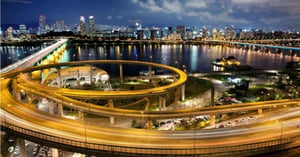This city portrait is in two parts. The first part, Seoul Smart City: The Power of Citizen Participation, described the reorganization of the Seoul Municipal Government to empower citizens and create a stronger climate of citizen participation at all possible administrative levels. The second part takes a closer look at some of the specific smart solutions being implemented by the city.
A Smart City with Seoul
The heart and soul of Korea’s mega-city capital are its 10 million-plus people. The government under Mayor Park Won-soon has recognized the importance of citizen participation in governance and has generated an environment where citizens can collaborate effectively across the different levels of government administration. This has been affected by changes in policy and governmental philosophy, which have provided multiple channels for citizens to engage and contribute to a scheme of partnership governance (see Part I of the Seoul Smart City Portrait for more details). The Civic Participation Administrative Philosophy and the Seoul Innovation Bureau set up and run directly under the office of the mayor, enable citizens to take part in all stages of smart solution planning, creation, implementation and evaluation in their city.
As well as the ongoing development of its e-services and open data ‘plaza’ (https://opengov.seoul.go.kr, https://data.seoul.go.kr), the Seoul Municipal Government has provided collaborative physical spaces in which people can meet, relax, and innovate. In the City Hall, for example, a large space has been set aside for public use and hosts lectures and discussions as well as community recreational activities. Other collaborative innovation centres have been set up all around the city.
Seoul Innovation Park is a creative space on a much larger scale that includes a Living Lab for social innovation experiments across many of the six smart city fields of action. Opened in 2015 in Eunpyeong-gu, it includes the ‘happy parking alley’ (an experiment in sharing private parking areas), a virtual reality maker space, a project to re-use waste batteries, and a project developing a system for the integrated education of those with and without disabilities. The park also provides a pleasant open green space, attracting both residents and visitors to the city. Its outdoor plaza hosts cultural events that encourage social interaction, such as fairs and festivals as well as regular flea markets.
The actions of Seoul’s Innovation Bureau appear to be working: in 2017, thirty-five projects initiated by citizens were included in the city’s budget, and fifteen city boroughs had adopted the new operating philosophy, including fostering public-private governance partnerships with citizen committees.

“With its successful civic participation policies and the related support infrastructure, the City of Seoul shows how important citizen participation and citizen innovation are for the creation and implementation of smart city solutions. Smart Citizens - or better 'Smartivists' - can make important contributions to improving the city, if they are properly enabled to do so.", states Thomas Müller, Managing Partner at bee smart city.
Smart Mobility Initiatives in Seoul
One such public-private partnership involves a city-wide monitoring system in which citizens can currently participate, called the Hopeful Seoul Monitoring System. Rapid urbanization since the 1970s initially led to the construction of multi-lane overpasses in an attempt to handle the city’s 50-fold increase in vehicle traffic. The monitoring system seeks to prevent traffic congestion of all kinds by tracking the flow of both vehicle and pedestrian traffic around the city in real time, as well as monitoring the use of public transportation via a smart ticketing system. Connected to this, the TOPIS intelligent traffic monitoring system watches for roadworks or emergencies and automatically alerts the appropriate authorities as well as bus services and the city’s private residents, helping them to make smarter transportation choices based on real-time information.
The government of Seoul also wishes to work with its citizens to change the city’s traffic culture, with a focus on road and pedestrian safety, and heading away from cars and toward a lower mobility society.
The city’s vision is one in which alternative methods of transportation eventually render individual car ownership unnecessary – and they aim to achieve that vision by 2030. To succeed in this ambitious goal, the surface area of pedestrian paths will be doubled and both walking and cycling will be heavily promoted, including the provision of a free public bicycle service. The Seoul subway system is already considered one of the best in the world, and the city intends to make it the centre of an improved, faster and more convenient public transportation service.
One step toward cutting smaller vehicle traffic and making transit across the city safer involved the monitoring of phone calls requesting taxi services after midnight when public transportation was no longer available. This led to the development of nine new ‘night bus’ lines across the city. The lines were designed based on an analysis of the origins and destinations of around 3 billion callers.
Smart People Initiatives in Seoul
On top of the activities of the Seoul Digital Foundation and the city’s classes educating people on how to innovate and how to better take part in their partnership governance system (described in Part I of the Seoul Smart City Portrait), various social groups and organizations have been established to support different demographics, such as the Seoul Social Economy Centre. Set up in 2013, the Centre was designed as a hub for collaborative innovations toward a more sustainable social economy, connecting innovators and entrepreneurs at different stages of planning and implementation with social organizations and social support agencies. Seoul also organizes innovation meetings of certain local companies so that they can work together to find smart solutions for social problems.
The municipal government also strongly supports the creation of local communities, fostering community centres and actively connecting innovators and other problem solvers within their local areas, generating a stronger sense of community and ownership and creating multiple ‘autonomous labs’ for testing new smart solutions all around the city. The Seoul Community Support Centre is an example of this strengthening local community culture. It helps to forge and support local, autonomous communities that plan and create within their own spaces based on their particular priorities. This ensures that all projects and, importantly, their budgets, are focused entirely on what each group of people needs, rather than the city forcing top-down solutions onto each community that may not be so relevant or effective to solve their problems. So far, around 129,000 people have actively participated in community-led projects and, where these communities are being built, residents report higher levels of satisfaction in their city life.
The Seoul Youth Hub places a greater focus on the needs and desires of the city’s younger citizens. As well as providing physical spaces for collaboration and networking, it is involved in youth policy, supports Seoul youth innovation by providing maker spaces and connecting engaged youth with innovation networks, and helps to tackle youth education and unemployment. The Youth Hub is co-managed by a public-private partnership between the Seoul Municipal Government and Yonsei University.
Smart Environment and Smart Living in Seoul
To turn Korea into a role model for sustainable (‘green’) growth, a new National Energy Plan proposed in 2014 outlined a desire to redirect the country’s energy generation from a centralized, supply-based strategy into a distributed, demand-based one. The equivalent of USD 20 billion was dedicated to developing a new industry and supporting technological innovations around this concept, helping to commercialize relevant technologies such as the generation of a smart grid, and forging new relationships between Korea’s government and industry. The plans also outline intended international collaborations, including the creation of a package to assist developing nations in achieving similar endeavours.
In Seoul, several projects are underway to further the country’s energy vision. The municipal government mandated that at least 6% of the energy generation for all buildings must come from a renewable source; in 2018, this requirement will be increased to 18%. A separate proposal by the Seoul Municipal Government supports the development of fuel cell technologies. Having already established some fuel cell-based power plants in the city, it plans to continue building this form of decentralized energy generation to supply 420,000 households by 2020. Combined heat and power facilities – using the waste heat from incinerators or power generation for heating – are also part of the District Energy plan, an initiative which hopes also to reduce greenhouse gas emissions.
The reduction of other types of waste is also well underway. Since as far back as 1995, Seoul citizens were made conscious of the amount of garbage they produced and were encouraged to reduce it through the implementation of a smart waste system. Based on the concept ‘Pay as You Throw’, the scheme has citizens pre-purchasing special garbage bags priced depending on their size (in litres). Early evaluations of the system determined that it had not only reduced the amount of waste produced but had also encouraged the proper, separated disposal of recyclables. The system has since undergone many changes, including a project to collect and charge for food waste based on weight instead of volume, which is estimated to have reduced total food waste by 10-30%.
Water management in Seoul is also under scrutiny, where the concept is changing from linear to cyclic to account for the whole water use cycle. This project is based on policy changes, covering water use, sewerage, water reclamation options, and the management of water quality. In 2004, the Citizens Environment Watch was established as a collaborative network designed to preserve the environment by monitoring the transparency and effectiveness of the authorities responsible for checking facilities that discharge pollution – another example of the sort of public-private enterprise encouraged by the new administrative philosophy of the Seoul Municipal Government.

"The City of Seoul can be regarded as a role model for shifting the focus of smart city development from a technology-centred approach to a purpose-driven and successful citizen-centric strategy. The cultural mindset - outlined as the new administrative philosophy in the two parts of this city portrait - is a key determinant that other cities can learn from. Together, organizational culture, enabling initiatives, and supporting infrastructure form the recipe for success.”, recognizes Bart Gorynski, Managing Partner of bee smart city.
Access Hundreds of Smart City Solutions for Free
For more best practice solutions, explore the global smart city network with its comprehensive solutions catalogue, featuring 600+ solutions implemented in more than 1.000 cities and communities. Join today and contribute to creating smarter cities and communities together with thousands of smart city enthusiasts from around the globe.
JOIN THE GLOBAL SMART CITY COMMUNITY

